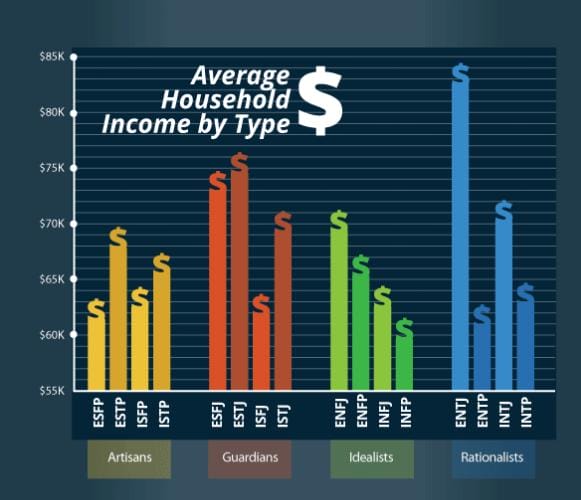Source: Career Assessment Site
The above chart shows the average income of different Myers-Briggs personality types. The 16 personality types were developed in the mid 20th century to help people determine their ideal career and workplace. In the Myers-Briggs test, individuals answer questions that indicate where they fall across 4 dichotomies: extraversion vs introversion; sensing vs intuition; thinking vs feeling; and judging vs perception. There are no good or bad types – merely different ways of experiencing the world that come with their own strengths and weaknesses.
For example, someone with the type ESFP tends to be more extraverted, more sensing than intuitive, a thinker rather than a feeler, and a judger rather than a perceiver. The site that created the above graph refers to someone with a type of ESFP as “The Performer” and describes his or her strengths as working with others, adaptability, and using common sense. (The name, as well as the categories of Artisans, Guardians, Idealists, and Rationalists, are not part of the original classification.) Potential weaknesses include long-term commitments, taking things personally, and not taking criticism well.
It’s tempting to draw conclusions from the outcomes of various Myers-Briggs types. The high average incomes of ENTJs seems right: the makers of the infographic dub the type “The Field Marshall” and describe the type as good with money, controlling, decisive, intimidating, and goal-setting – classic CEO and high-powered executive material. It’s also interesting that the next two highest remunerated personality types are given the nickname “The supervisor” and “The provider” respectively.
But there is also reason for caution in drawing conclusions from this graph – or trusting the personality types too much in general.
One reason – stressed by Katharine Briggs and Isabel Myers – is that these personality types are a preference rather than an ability. INTPs are not born INTPs who are destined to live and die INTPs. Nature and nurture make a personality type. Someone with an inclination toward thinking over feeling could choose to focus on feeling more and change their personality type.
Another reason, quite simply, is that the makers of the infographic do not explain the source of their data or their methodology.
But the biggest reason, which has ramifications for nerdy advocates of Myers-Briggs types and HR offices that rely on the test, is the limited evidence for its utility. One article questioning the Myers-Briggs method, which opens with the image of a career adviser who used phrenology to understand his clients, notes:
It displays what statisticians call low “test-retest reliability.” So if you retake the test after only a five-week gap, there’s around a 50% chance that you will fall into a different personality category compared to the first time you took the test.
The article goes on to describe criticism of Myers-Briggs for forcing people to choose one side of these 4 assumed dichotomies – so that someone who falls about equally between introversion and extraversion ends up categorized as one or the other. Finally, the article quotes a psychologist who says that there is “no evidence to show a positive relation between [Myers-Briggs] type and success within an occupation … nor is there any data to suggest that specific types are more satisfied within specific occupations than are other types.”
If Myers-Briggs’s utility is oversold, its longevity has much to do with its appeal to Human Resources departments as a reassuringly scientific crutch – and its moneymaking potential. The exclusive distributor of Myers-Briggs materials, CPP, charges $1,695 for 3 day classes to become a Myers-Briggs type indicator certified practitioner, $119.50 a pop for 15 minute video introductions to the Myers-Briggs test, and $25 for each report on an application of Myers Briggs types for the workplace (ie for conflict resolution, decision-making, and leadership).
This author, like many others, has found Myers-Briggs to be an intuitive system that seems quite useful. But it might be time to give this much loved test another look.
To get occasional notifications when we write blog posts, sign up for our email list.




